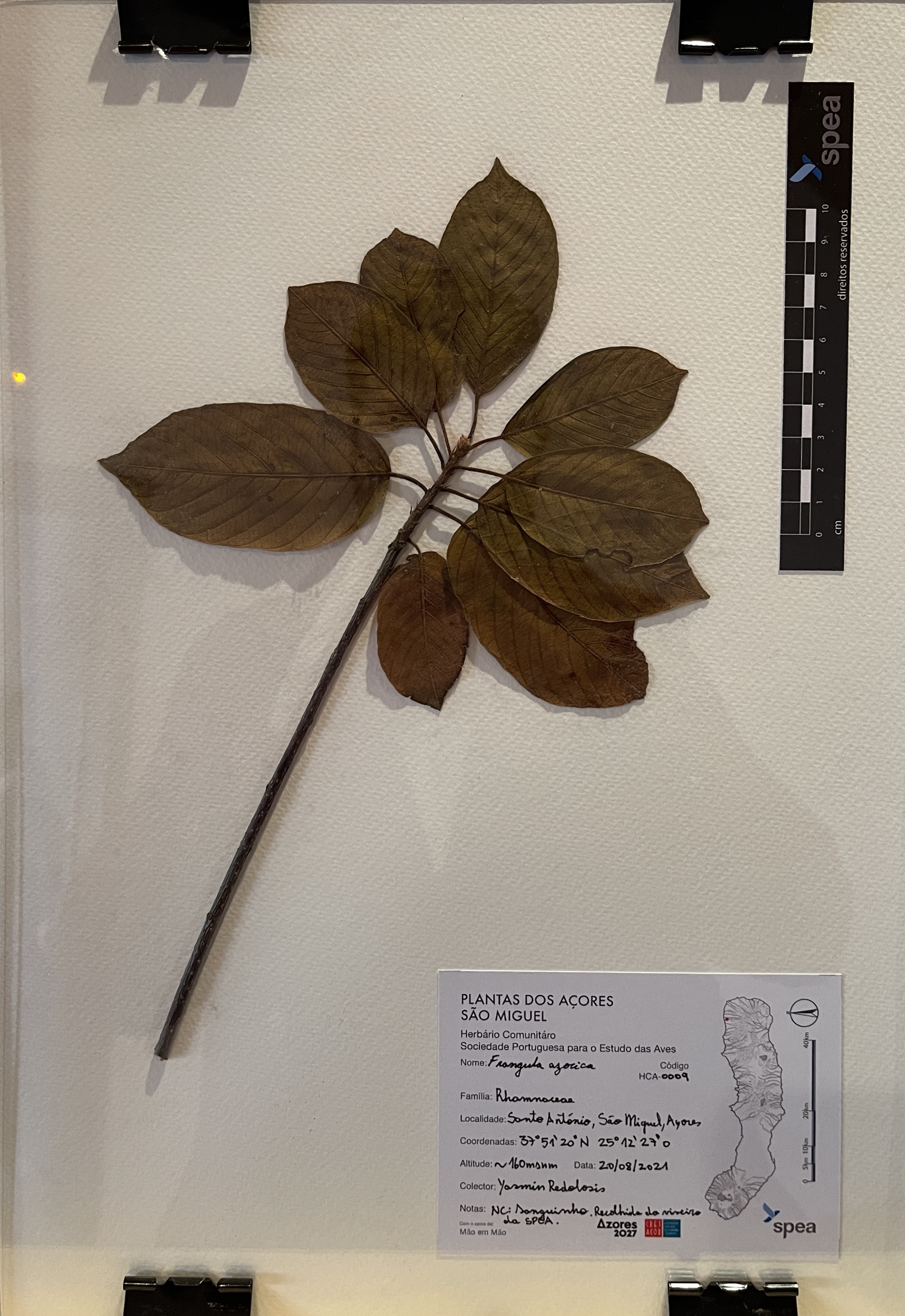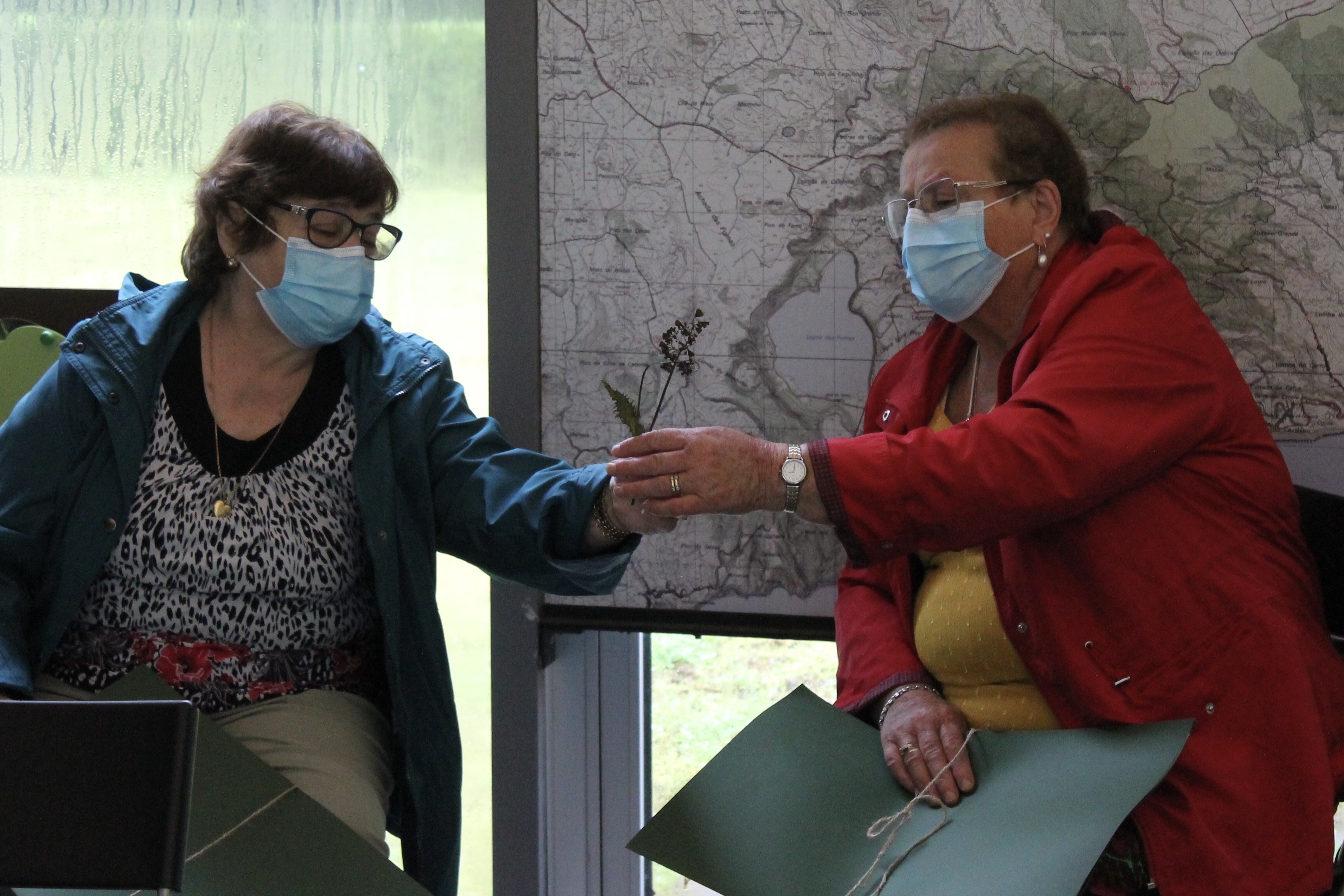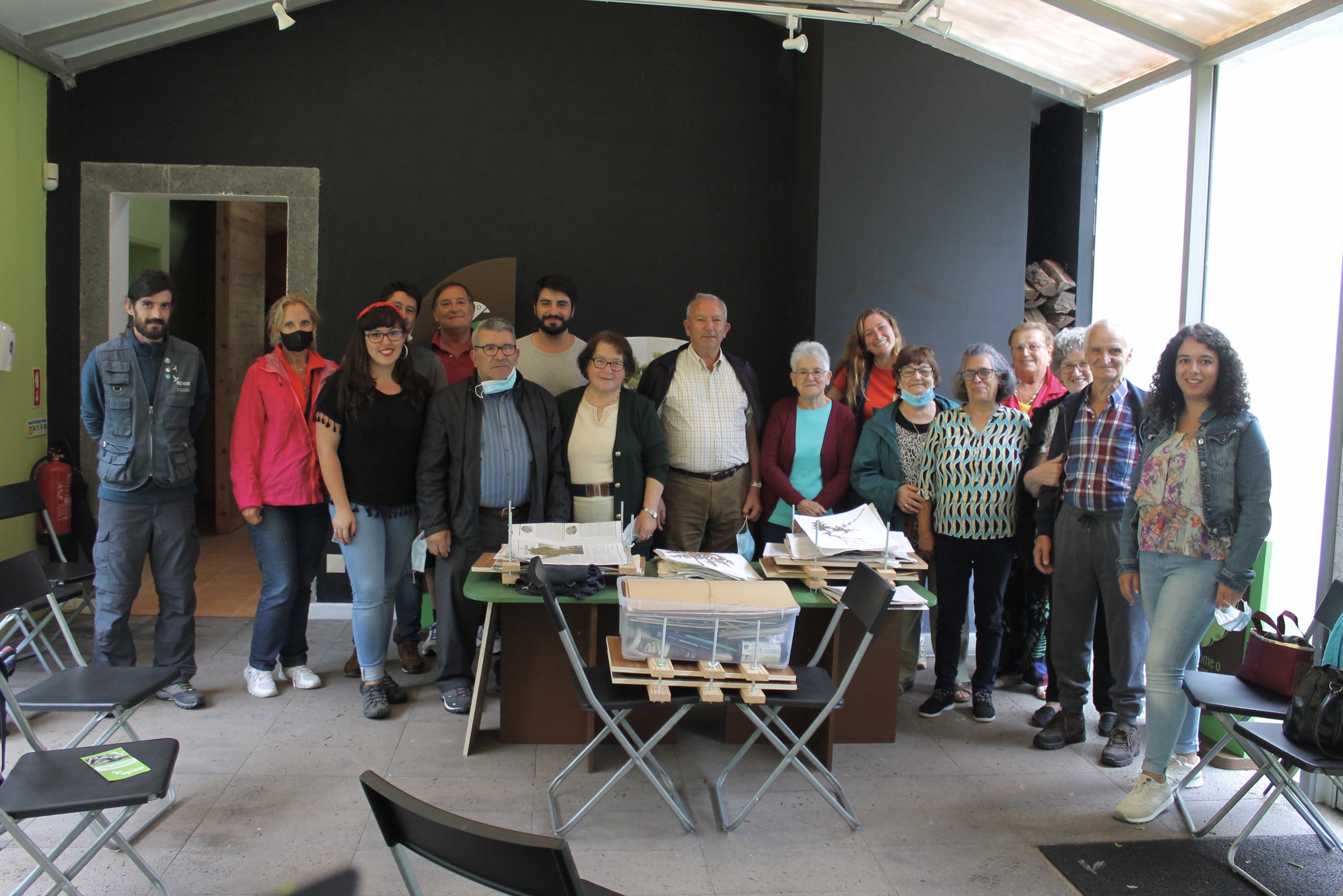This communitary herbarium is a scientific object created by the local inhabitants and displayed in a way that conveys the beauty of the native species and of the construction process. Local youth and elders collect the samples, performing naturalistic observation and creating art pieces in the form of drawings and poems. This way, they create an emotional relationship with the territory and acknowledge our interdependence with biodiversity, which promotes the adoption of new habits.
The communitary herbarium is simultaneously an environmental education activity for the population of Nordeste municipality in São Miguel, Azores and an exhibition that aims for a wider audience. This project aimed to bring locals closer to the natural heritage of the archipelago, deepening their knowledge and connection with the native vegetation that unfortunately is a great unknown to them.
An herbarium is a collection of dried, preserved and identified plants or plant parts. Each specimen is cataloged with information such as the scientific name of the species, the identity of the collector, the place, the date of collection, etc. These are used as material for the study of botany, research and environmental education.
In this case, a scientific herbarium was built with the help from youth and elders from Nordeste. These participants had the opportunity to approach the native vegetation, through naturalistic observation and scientific information on its origin and importance. Selecting a native plant and collecting a sample to be included in the herbarium, the participants collected more than 100 specimens of 31 different species. Afterwards, they were invited to express their experience in the form of drawings or texts.
The results of these activities were later transformed in an exhibition that includes the collected and dried specimens framed with all the scientific identification including the name of the collector; photographs of the activities that show the moments of connection of those participants with nature and their own art pieces produced in the process. This exhibition was displayed in an interpretation center in Nordeste and a house of culture.
The whole process results in a deep connection with their natural heritage that is transmitted to the visitors of the exhibition when they observe the framed plants, photographs, drawings and poems, also contributing to increase their awareness on the need to preserve nature.
Please highlight how the project can be exemplary in this context
Through all the process of implementation of this project, we were fully aware of the need to ensure its sustainability. For this reason, we favored reutilization of materials, when possible, and the use of biodegradable and recyclable materials.. For example, for the curatorial process of the plants, we used old newspapers instead of buying special papers.
Also, the choice of materials used in the activities and in building the exhibition priorized the use of local wood:Cryptomeria japonica, thus reducing the ecological footprint of transport. In addition, in the creative process of the structures and supports for the exhibition, the design sought to minimize waste of this material. This use of endogenous, biiodegradable materials, also contributes to the estetics of the exhibition and to the message that it aims to trasmit to the visitors regarding the importance of the preservation of our natural heritage and the health of the planet.
The main objective of the project is to reconnect the local population with the native species of the Azores. These species are seriously threatened by the presence of exotic and invasive species that are often more familiar to the locals themselves. Therefore, by bringing the community closer to these native species, we promote awareness of the importance of conservation of severely vulnerable habitats and biodiversity in general.
The transfer of the exhibit to a local entity allows it to be reused and its impact to go beyond the local context in which it was built, extending it to the rest of the community of the island of São Miguel and the Azores and extending it over time.
Please highlight how the project can be exemplary in this context
The importance for aesthetics was a constant in all the process of creation of the Communitary herbarium. This is visible in the care for how the plants are displayed in the exhibition. The modular structures provides order into space and allows adaptate the distribution to many spaces, the attention in capturing key moments of discovery in photographs and the inclusion of the drawings and text created by the participants in the collection moments.
In this way, the plants are transformed into art pieces. The composition in the exhibition space allows us to observe the details and compare them to better understand them, discovering the unique beauty of each species and each specimen. Also, the exhibition shows the beauty of the discovery moments created in the collection of the plants. To include it, the exhibition has a selection of photographs and drawings that reflect part of the work done, where smiles are part of new narratives of the relationship with biodiversity and the drawings are a conscious way to bring and represent this re-signification of the relationship with nature.
This way, the exhibition is not a final product, but it also includes the process of preparation as an important part of the project, where direct contact with the territory was fundamental in the individual and collective experience. In addition, the link between rigor and aesthetic care allows the plant samples to fulfill a functionality as material for the disclosure of natural heritage, environmental education and botanical study by academics and researchers.
Please highlight how the project can be exemplary in this context
The project seeks to highlight the importance of the process of reconnecting with nature by proposing four outings with community participants. These activities consisted of naturalistic observation while plant samples were collected and drawings were made. As a way of democratizing knowledge and scientific participation, the participants themselves were responsible for the collection and preparation of the samples that constitute the herbarium. In fact, the name of each participant who collected a plant is included in the record of each specimen.
The project included different age groups, with the participation of two groups of senior citizens. This was significant because this is a group that generally has few opportunities to be involved in environmental education activities and, at the same time, they have a great potential because they have a childhood experience related to many of these species that can provide information for researchers and educators and also they can influence younger generations in changes of habits in order to protect the environment. Their participation allowed an exchange of information between the traditional uses of these plants and current scientific knowledge that contributed to enrich the final result of the project. For example, the common names compared to the scientific names, the location where they used to find the plants and the now lost uses themselves, plants for food, tool making, etc.
The project established partnerships with the municipality of Nordeste and an NGO with a local office (SPEA-BirdLIFE) in order to help with the involvement of this population and help with the costs of their participation. Also, the locations of the collection moments were adapted to the mobility of the participants, in the case of the elders, we chose a very accessible location to allow them to be able to conduct all the recollection process.
Please highlight how this approach can be exemplary
The project combines the three dimensions in both the process and the result. In the process of the realization of the project, the way the activities were conceived, with the will to be inclusive with the community, with the concern to be environmentally conscious and with the rigor of having beauty present in all the stages. The activities were designed in different places according to the capabilities of the various groups, where folders with fully biodegradable materials were given to each participant, not only taking care of the aesthetics in the material worked, but also allowing it to appear through the work of the participants, with their collections and drawings. Each drawing is unique and personal because it shows a different experience, it shows our individuality but also allows us to recognize that we are part of a community, including nature.
According to the participants themselves, the activities allowed them to "see what they had never seen before", because frequently we do not have the time to stop and observe. As a result, the project ended with an exhibition, which summarizes and brings together very well the care for sustainability, aesthetics and inclusion. The participants were able to see how their work was treated with care and was given added value through the design, where the structures were specially designed to display the herbariums, photographs and drawings.
The project sought and achieved a positive impact on two fronts. The first is the 39 participants who collaborated and carried out the field work. That is why it is important to emphasize that in this project it was fundamental to carry out a process for the creation of the herbarium. The particularity of this initiative lies in the fact that the knowledge was not only elaborated by scientists or specialists, but on the contrary, it sought to involve the community as part of this process, transforming them into authors and creators of the knowledge. This participation allowed the volunteers to have access to first source knowledge, in contact with nature, sharing the technical/scientific dimensions with the popular wisdom and many years of experience of the elderly participants.
The second positive impact achieved by the project was through the exhibition, with which it manages to recover and put into value the natural heritage of the archipelago, often hidden by other more striking exotic plants, but which are not part of the ecosystemic dynamics of the islands. This exhibition also allows the rest of the community to have access to the knowledge elaborated through the herbarium, proposing a new look from the aesthetics to re-signify the relationship with nature.
Please also explain the benefits that derived from their involvement.
The community was involved in the process of making the herbarium, as a way to deepen and put into value the natural heritage of the Azores. They were given basic tools for understanding the laurel forest, its importance and why we must protect it. The participants contributed directly to the final exhibition through the collection of plants and the production drawings and texts during the activities.
Also, visitors to the exhibition are confronted with the beauty in the native plants of the Azores and the importance of this rediscovery of the natural environment through the eyes of those who participated in the collection.
The active participation of the community allowed for the enrichment of the project and directly influenced the final design of the exhibition. Having done the field work allowed the participants' experiences to appear, which added a special value to the drawings and the stories told that were captured in the exhibition. The need to include the process meant giving a face to the creators of the herbarium, so photographs of the activities were included. These, in addition to showing the authors of the collected pieces, allow us to appreciate how this experience is transformative in the way they themselves perceive and inhabit nature. From their side, the drawings reflect a capacity for synthesis to represent and capture on paper a word, an emotion, a poem, a plant, an experience.
In this way, the project became something more than a herbarium, a meaningful experience for the inhabitants that is transmitted to all those who visit the exhibition. In this way, it generates awareness in the community and allows the elderly to have a space in environmental education. In this way, the inhabitants are empowered so that they can access knowledge of their natural heritage and value it, demonstrating that it is possible to create novel and beautiful initiatives that are also inclusive and respectful of the environment.
The loss of biodiversity has accelerated in recent years, through habitat degradation and overexploitation of the territory. This is a global problem that is accelerated by the disconnection of human beings with nature. We are increasingly an urban society that is dependent on technology and has forgotten our inter-dependence with the rest of the living beings that make up the planet. This exhibition aims to encourage this reconnection by recovering the awareness that we are one more species, and therefore dependent on the balance of ecosystems. Raising awareness about ecosystem services and the importance of their conservation allows us to reintroduce dynamics of connection with nature through citizen science activities, environmental observation and field work. Here, the proposal sought to access knowledge about biodiversity while enjoying nature with respect and care for its preservation.
This is not an environmental education project, nor is it a research project, and it is not exclusively an artistic exhibition, but at the same time it is all three. This union seeks to generate knowledge, disclose it, and at the same time include the community in a process that allows its reconnection with nature through a direct experience with the territory.
The particularity of this project is that it joins the philosophy of doing with the methodology to generate a proposal to involve the community in a co-participatory and co-creative process of discovery of the native and endemic flora.
It is also innovative to have worked with senior citizens because they are people who have experience with the plants of the archipelago, when these projects are usually carried out with children. In this case, in addition to generating new experiences, it opens the possibility of re-signifying past experiences. As an example, one of the participants told us that when she was young she was never interested in plants, they had no value for her, and she regretted not having discovered them earlier, but at the same time she was grateful that this experience had allowed her to rediscover the beauty and importance of these native species.
Please provide clear documentation, communication of methodology and principles in this context.
Many entities develop environmental education and/or nature conservation projects, aiming to raise awareness in communities about the importance of preserving the various ecosystems. This proposal can mark a line of work in the path of reconnecting human beings with their existence as a species within the diverse ecosystems of the planet. This is done on the one hand, through direct contact, observation and permanence in the territory during the collection activities. And, on the other hand, the care for aesthetics and the transformation of this material into a work of art reinforces the value of the experience itself, and allows it to be transmitted to a wider group of people.
The great potential that this project has is that it can be replicated in whole or in part in multiple contexts, generating initiatives that take advantage of this philosophy and methodology. Proposing new projects that involve the community actively in the process of conservation and research of biodiversity, along with the artistic/creative process of building a final product that puts these elements in value. For example, from this project other collaborators are currently thinking of making a replica for the LIFE Ilhas Barreira project, but it could also be rethought using other groups of species such as insects, or other types of naturalistic observation activities through drawing and/or photography.
News story about the project of the Community Herbarium: https://fb.watch/boY-deRvhB/



@BrunoMarambio Márquez, 2021
Content licensed to the European Union.